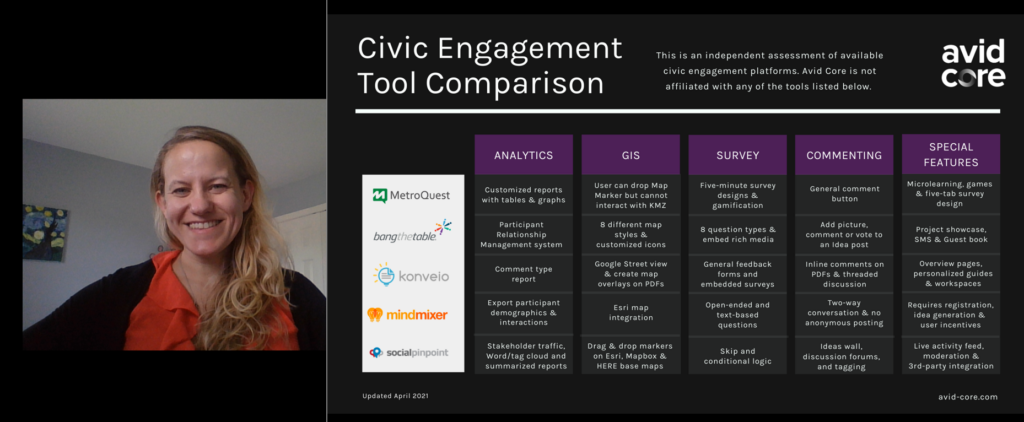Avid Core co-founder Amanda Roberts recently presented on this topic at the National Environmental Health Association (NEHA) 2021 Annual Educational Conference (AEC) & Exhibition Three-Part Virtual Series. If you are interested in learning more, download our free resources or contact Amanda.

Virtual public engagement processes offer new opportunities for inclusion and accessibility. As planners, we must ensure our process allows for effective and meaningful participation of low-income, minority, and hard-to-reach communities.
Over the past year, three major events have modified the way we think of public engagement today.
- The COVID-19 pandemic forced organizations to cancel in-person engagements and accelerated the adoption of digital technologies.
- The murder of George Floyd and the Black Lives Matter movement amplified awareness of systemic racism and spotlighted how individuals and organizations contribute to unfair systems and practices.
- President Joe Biden was elected and his first day in office, he issued two executive orders—one on advancing racial equity and support for underserved communities and another reaffirming a commitment to Environmental Justice.
Every community is unique so there is no magic formula to comprehensive public engagement, but there are steps we can take with every engagement to ensure we are reaching all audiences including those historically left out of the planning process.
Assessment
Every project should start with an assessment to understand if current engagement efforts truly engage stakeholders that are representative of the demographics of the impacted community or region.
You can start by looking at your existing stakeholder lists and examining:
- If your list is only self-selected.
- When the list was collected and the last time it was updated.
- If the organizations are representative of area interests.
- If tribes, especially those with ancestral lands in the area, are represented.
- If there are gaps in geography.
Look at the media for key stakeholders and experts. You may be noticing a person who is repeatedly quoted on community issues. If your project has the potential to impact that community, it would be a good idea to engage that stakeholder early. Also look for news coverage in non-English publications to see if there are experts that serve those communities.
You’ll want to do the same for social media. Facebook, Twitter, LinkedIn can help identify interested and active members of the public. Reddit can be useful for identifying public sentiment on particular topics.
And, of course, ask your known stakeholders who else you should be engaging.
Once you have a comprehensive list of stakeholders, you also need to understand how those stakeholders would like to be engaged through interviews and surveys. Understanding this information will help determine your key messages and tactics.
Planning
After you have a good understanding of the populations and their interests, you develop a plan for engagement. I like to direct people to the International Association for Public Participation’s Spectrum of Public Participation when they are thinking about their goals for public engagement. On one end of the spectrum, you are pushing information out and on the other end of the spectrum, you are receiving information and giving the public all the decision-making power. Understanding how you want the public to shape your project is important to define at the beginning and help you decide where to invest resources.
You need to evaluate and prepare for the monetary cost and time investment for engaging with Environmental Justice communities. You may need to only send an email to get the most active members of the community engaged whereas a community member from a traditionally underserved group may require an email, canvassing, information from respected community leaders, and language interpretation. You are investing more resources to get the same level of participation in the project, but comprehensive engagement is worth the effort.
As you are building your plan, you also need to understand that many communities, especially tribal communities, need time to process the information and expect to engage in a formal consultation process. That additional time needs to be built into your plan. You also must add into your timeline the process of distributing information. Canvassing, mailing, and distributing materials through trusted community partners takes longer than having handouts at a single meeting.
Your plan should also identify messaging for your project and make sure it’s accessible to those you are trying to reach. Use plain language, avoid jargon, and write to a fifth grade reading level. You should be able to describe this project to a friend or family member who has no technical knowledge, and they should understand what you’re working on.
Execution
With all the changes over the past year, organizations can no longer fall back on the way it’s always been done. But consider how many people were excluded when you weren’t digital, such as younger populations, those with non-traditional working hours, and those with limited English proficiency.
To ensure a robust public participation, you will likely need to take a hybrid approach to public engagement where you combine traditional outreach methods with new technology.
Example combinations include:
- Multilingual Website + Mailer + Video
- Livestreaming + Polling
- Social Media + Partnerships + Conference
- Email Campaign + Phone Call + Webinar
- Digital Mapping Tool + Site Visits
- Pop-up Events + Online Survey
- Community Listservs + Newspaper Notice + Online Public Meetings
The right blend is dependent on your audience and their specific needs.
Evaluation
The last part of our process is evaluation. It’s important to understand if your public involvement process has achieved its goals of reaching underserved and marginalized communities.
Digital tools have powerful analytics built into their system—you can understand a lot about participants without asking them a single question. How they accessed your site, what they spent the most time looking at, and where they are located are all available through built-in analytics. However, you will likely need to supplement this information with a survey to understand the demographics of everyone who participated in the process.
Once you get this data, if you still see gaps in your outreach, you need to go back to the assessment and planning phase and look at what might need to change to get representative input.
Public involvement processes are constantly changing and the last year has spotlighted the public’s adaptability and willingness to embrace new technology. Now it’s up to organizations to build those accessible options into their plans from the start and keep the focus on representative participation from all community members throughout the process.
